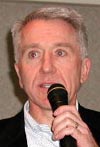|
The Story of the Washington Park Arboretum
One of the treasures found in the center of Seattle is the Washington Park Arboretum, established in 1934 and covering 230 prime acres south of the University of Washington across the Montlake Cut.
 Fred Isaac, a Sammamish resident retired from a career with the FAA, is now President of the Arboretum Foundation Board of Directors. Fred came to illustrate to the Club the jewel represented by the Arboretum and to lay out plans for the future. Fred Isaac, a Sammamish resident retired from a career with the FAA, is now President of the Arboretum Foundation Board of Directors. Fred came to illustrate to the Club the jewel represented by the Arboretum and to lay out plans for the future.
“The Arboretum is in your backyard. It’s truly a Northwest treasure,” effused Isaac. “It is home to the largest inventory of woody plants in North America. It’s a greenbelt in the midst of dense populations. Within its boundaries, there are 4,400 woody plants, many of them endangered species. The Arboretum is many things to many people. It’s a park to some, a living museum to others.” The City of Seattle owns the property; the University of Washington maintains the plants. The Arboretum began in 1894 on the UW campus, established by Edward Meany. It was relocated to its present site in 1934.
“At the time of its relocation, the area was 90% clear cut to make room for the new Arboretum,” said Isaac. It is nearly the largest park in Seattle. In 1936, the Olmstead Brothers submitted a design for the park. Between 1936 and 1938, the WPA did much of the heavy work to develop the site.
In 1985, one of the major projects completed was the Visitors Center. It was built by funds provided by the Arboretum Foundation and deeded to the City. It is occupied by the UW and the Foundation. The Center is the check-in point for tours. Over 300,000 visitors take tours annually. Two of the most popular areas are Azalea Way and the Winter Garden, where many winter flowering species are displayed. The park is a learning venue for kids with tours conducted for 3,000 per year. Isaac noted there is a potential for 15,000 children taking tours, but the resources aren’t there yet.
Isaac explained how the Park is governed. “The City of Seattle maintains roads and streets, the visitor’s center, and does maintenance on the flora. The University is in charge of collection of plants. The Foundation provides resources for projects and conscripts volunteers. It’s a funny foundation – it starts with no money, it raises some, and then gives it away. The foundation raises funds through memberships and annual plants sale. It also receives funds through sponsorship of the Northwest Flower and Garden show Preview party.” The Foundation boasts 2,500 members from all over the state.
* * * * *
Master Planning for the Future
Isaac pointed to the need for improved access to the Park, the renovation of gardens, more visitor amenities, better education facilities, and a stepped-up program of safety for those who visit. “The Master Plan was begun eight years ago. It was seven years in the making, with the initial results controversial. We tried to learn how the arboretum should be used and developed. There was an extensive public process of input and, frankly, we ended up with a better plan, which was approved in 2001.”
Early projects include “daylighting” Arboretum Creek to make room and environment for salmon runs. The drainage is bad on Azalea Way. The Park’s maintenance facility is too small for the size of the job. Handicapped improvements and new shelters, a new educational gateway at South end, and additional public facilities are all part of the newly adopted Master Plan.
* * * * *
Fundraising Efforts
|

President Kim Shrader (R) thanks Fred Isaac for his presentation.
|
“There is widespread support for the Arboretum,” Isaac observed. He told his audience how they could help. “It a great public asset, it’s good for kids and for citizens … it’s our Central Park. Joining the Foundation costs as little as $25 a year. The Foundation publishes bulletins and newsletters. Many Foundation members are also members of professional organizations, and we know how to stretch a dollar. Spring is a great time to visit the Arboretum … April one of the best months.”
Isaac had mentioned the Stone Cottage, which was built during the Arboretum’s early days. “Today, the Stone Cottage is occupied by a person — usually a UW student — whose job it is to open and close the gates. There are lots of prominent names on the walls of the cottage. It’s only heated is by the fireplace … the cottage couldn’t be over 300 square feet!”
|

Cary Kopczynski introduces Fred Isaac.
|
The last weekend in April is the time for the annual Arboretum Plant Sale. “There are unusual plants for sale. This is the Foundation’s major fundraising event.” When asked about how the Washington Park Arboretum ranks with others, Isaac said that he’d guess it’s one of the top 25 in world. The annual budget is $500,000. The Foundation maintains a small endowment. Most of the money raised is spent the same year. The University contributes a third, the City a third, and the Foundation a third toward the operation of the park.
Fred Isaac became a member of the “240 Doses Club,” BBRC presenters who’ve received a certificate that 240 doses of polio vaccine have been donated in their name. Thanks to Cary Kopczynski for his introduction.
|